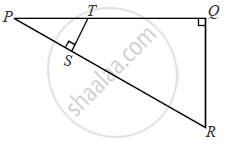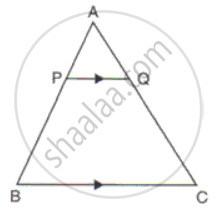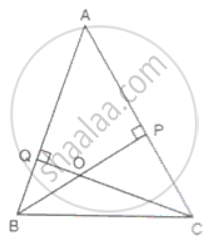Advertisements
Advertisements
Question
In the adjacent figure, ∆ACB ~ ∆APQ. If BC = 8 cm, PQ = 4 cm, BA = 6.5 cm and AP = 2.8 cm, find CA and AQ

Solution
Given ∆ACB ~ ∆APQ
`"AC"/"AP" = "BC"/"PQ" = "AB"/"AQ"`
`"AC"/2.8 = 8/4 = 6.5/"AQ"`
Consider `"AC"/2.8 = 8/4`
4AC = 8 × 2.8
AC = `(8 xx 2.8)/4` = 5.6 cm
Consider `8/4 = 6.5/"AQ"`
8AQ = 4 × 6.5
AQ = `(4 xx 6.5)/8` = 3.25 cm
Length of AC = 5.6 cm, Length of AQ = 3.25 cm
APPEARS IN
RELATED QUESTIONS
In ∆ABC, DE is parallel to base BC, with D on AB and E on AC. If `\frac{AD}{DB}=\frac{2}{3}` , find `\frac{BC}{DE}.`
Given `triangle ABC ~ triangle PQR`, if `(AB)/(PQ) = 1/3`, then find `(ar triangle ABC)/(ar triangle PQR)`
State, true or false:
All isosceles triangles are similar.
In the given figure, ∠PQR = ∠PST = 90° ,PQ = 5cm and PS = 2cm.
(i) Prove that ΔPQR ~ ΔPST.
(ii) Find Area of ΔPQR : Area of quadrilateral SRQT.

The dimensions of a buiIding are 50 m Iong, 40m wide and 70m high. A model of the same building is made with a scale factor of 1: 500. Find the dimensions of the model.
A model of a ship is made with a scale factor of 1 : 500. Find
The deck area of the model, if the deck area of the ship is 1500000 m2
In figure, PQ is parallel to BC, AP : AB = 2 : 7. If QC = 0 and BC = 21,
Find
(i) AQ
(ii) PQ
In ΔABC, BP and CQ are altitudes from B and C on AC and AB respectively. BP and CQ intersect at O. Prove that
(i) PC x OQ = QB x OP
(ii) `"OC"^2/"OB"^2 = ("PC" xx "PO")/("QB" xx "QO")`
A model of cargo tuck is made to a scale of 1:40. The length of the model is 15cm. Calculate: The length of the truck
Is the following statement true? Why? “Two quadrilaterals are similar, if their corresponding angles are equal”.
